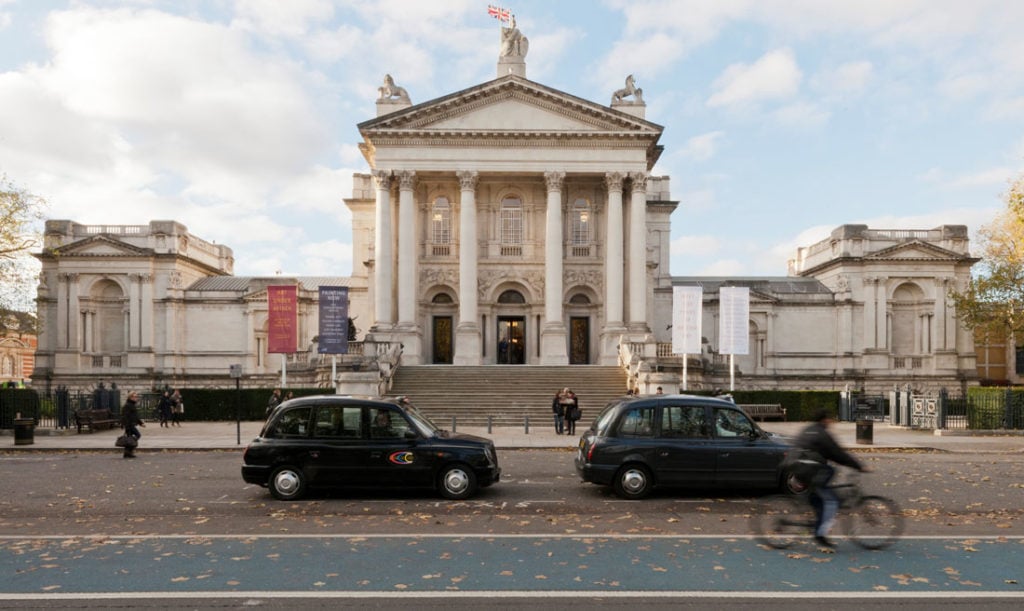Art World
The Little-Known Story of How Brexit Plotters Hatched Their Plans in the Galleries of Tate Britain
The covert meetings held by the "Tate Plotters" is the subject of a TV drama starring Benedict Cumberbatch.

The covert meetings held by the "Tate Plotters" is the subject of a TV drama starring Benedict Cumberbatch.

Javier Pes

In the early days of the Vote Leave campaign to bring about the UK’s withdrawal from Europe, a small group of hardline Eurosceptics, who eventually triumphed in their propaganda efforts to win the 2016 referendum, needed a place to scheme out of sight of journalists and colleagues.
Just a stone’s throw from Westminster, they found the perfect place: Tate Britain.
The “Tate Plotters,” as they became known, held numerous secretive meetings in the museum’s galleries, restaurant, and cafe in the four years leading up to the historic vote. Now, their story unfolds in the political drama Brexit: The Uncivil War, which was broadcast in the US by HBO at the weekend.
The film, which first aired on Channel 4 in the UK, begins with two Vote Leave founders—turncoat MP Douglas Carswell (played by Simon Paisley Day) and the political lobbyist Matthew Elliott (John Heffernan)—meeting in the museum to pick an “attack dog” to lead the campaign. Their choice is the maverick strategist Dominic Cummings, played by Benedict Cumberbatch in a bravura performance.
In the film, Elliott and Carswell’s meeting at Tate Britain takes place in front of a suitably patriotic painting: John Singleton Copley’s The Death of Major Peirson (1783), which depicts France’s failed attempt to invade Jersey during the American War of Independence. The history painting was handpicked by the film’s director Toby Haynes.
“It was surreal to watch,” the real-life Elliott tells artnet News of watching the TV film, adding that later meetings in Tate Britain included Cabinet ministers. He confirms reports that the gallery was chosen because of its location: close enough to the Houses of Parliament, but far enough away that the meetings would be discreet.
At the time, Elliott lived around the corner from Tate Britain. He says he would often pop in with his wife, the US-born lobbyist Sarah Elliott, who recently tweeted that on their first date in Washington, DC, in 2012, her future husband said that his next campaign would be to take the UK out of the Europe.
It was as a “pretty intense period of my life,” Elliott says of the times depicted in the film. Apprehensive before the broadcast, he told the Financial Times that watching the film “turned out to be cathartic and fun.”
Carswell, who quit the Conservative Party in 2014 to become the first MP of the hardline UK Independence Party, is reluctant recall his visits to Tate Britain. Asked by artnet News for comment, he responded: “I have left public life and have nothing further to add.”
The former MP now runs a digital communications company called Disruptive with Thomas Borwick, who formerly worked for Cambridge Analytica, the defunct data analytics company that offered to entrap a client’s opponents.

Tate Britain. Photo: Courtesy of Tate.
“How ironic to hear that [the gallery] was the home of the ‘Tate Plotters,’ of whom I have never heard,” says Penelope Curtis, who was director of Tate Britain at the times the meetings took place. “I wonder what (British) art the plotters might have been looking at? It seems more likely they chose Tate Britain because of the excellent (French and German) wines in its cellar.”
Meanwhile, the real drama of Brexit is ongoing. As the clock counts down to March 29, when the UK is due to leave the EU, there is still no plan agreed in Parliament for the divorce deal or no deal.